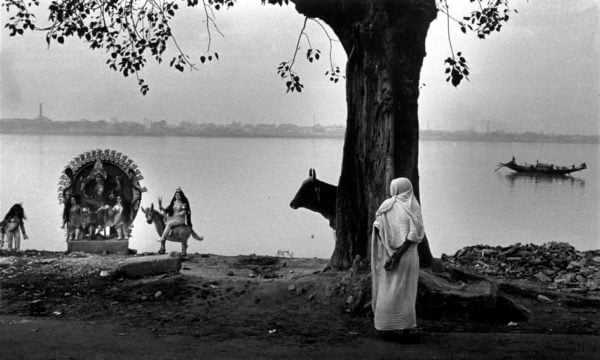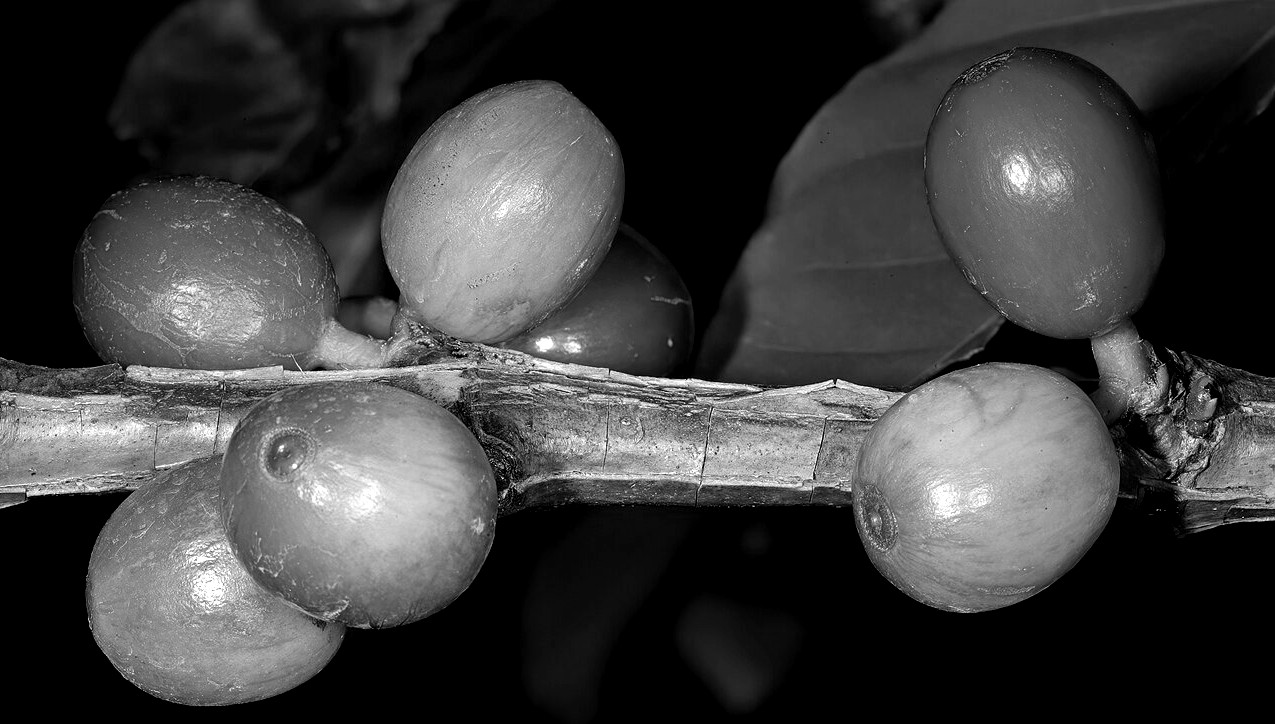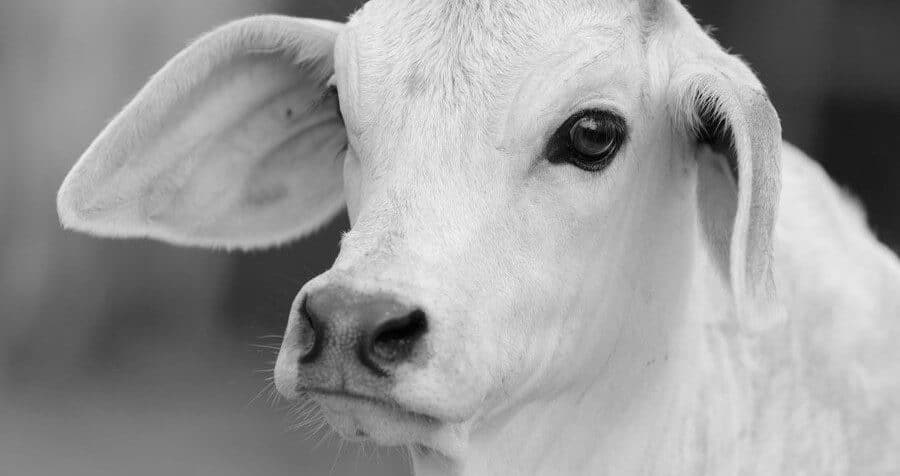The river Ganges meanders through various northern and eastern states of India, streams through Bangladesh, and vanishes into the Bay of Bengal. Ganga is a river and a goddess indivisible from each other. Her water has the power to cleanse — as most Hindus believe — every kind of sin.
Bathing in Ganga liberates the soul as does dying in it reaffirming the Hindu notion of Moksha – salvation. Discover the Mythology of the Ganges river or Mother Ganga.
In this Article
SACRED MOTHER GANGA गंगा
Ganga Mata of the people
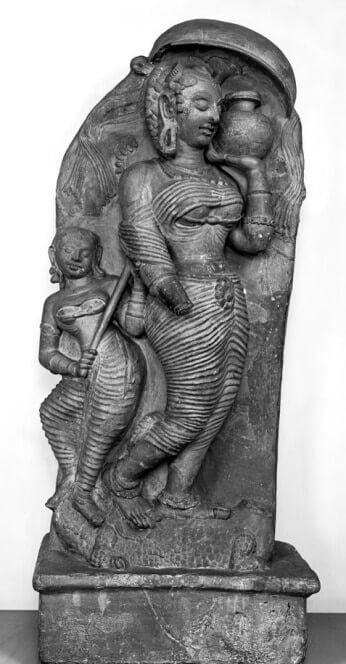
The whole river — from the Himalayan glaciers across the vast North Indian plain to the filigree delta on the Bay of Bengal — is worshiped as a life affirming goddess, holding an important place in the Hindu pantheon.
Though iconography of the goddess varies, she is most often depicted as a beautiful woman with a white crown. Her divine vahana (vehicle) is a Crocodile or the Makara– a creature with the head of a crocodile and tail of a dolphin. She features either two or four arms, holding a variety of objects ranging from water lilies to a water pot to a mala (rosary).
As a nod to the goddess गंगा Gaṅgā, the Ganges river is often referred to as Ma Ganga orGanga Mata or mother, accepting all and forgiving all.
The gravest of sins like Brahmahatya, thekilling of a Brahmin- priest cast (the highest cast) or Gauhatya, thekilling of a cow, gets absolved.
The Puranas state that the sight, the name, and the touch of the Ganges cleanses one of all sins and that taking a dip in the sacred river bestows heavenly blessings. For some devotees God Vishnu is Ganga, considered as the earthly embodiment of Krishna-Vishnu. Lord Vishnu has described the importance of Ganga, saying to Garuda – the eagle God, his divine vahana:
“Thousands of man’s sins get destroyed by the holy sight of the Ganges,
and he becomes pure by the touch of the water of Ganges, by consuming it, or just by pronouncing
‘Ganga – Ganga’”
Because of the purifying nature of the river, Hindus believe that any rituals performed at the banks of the Ganges or in its water will bring fortune and wash away impurity – pāpa or sins. Pāpa in Sanskrit, used to describe actions that create negative karma by violating moral and ethical codes.
For Hindus the world over, nothing is more holy or pure than Ganga jal, or water from the Ganges. According to Ganga Stotram (mantra): Devi Sureswari Bhagavati Gange by Shankara (CE 788 – 820) Sri Adi Shankaracharya, Part 7:
तव चेन्मातः स्रोतःस्नातः पुनरपि जठरे सोऽपि न जातः ।
नरकनिवारिणि जाह्नवि गङ्गे कलुषविनाशिनि महिमोत्तुङ्गे ॥७॥
(Salutations to Devi Ganga) O Mother, he who has bathed in the flow of Your Pure Water, he will not again take birth from the womb of a mother (i.e. have rebirth),
O Jahnavi Ganga, You save people from falling in the Naraka (Hell) and destroy their Impurities; O Mother Ganga, Your Greatness stands High.
Ma Ganga has numerous names, she is described as the melodious, the fortunate, the cow that gives much milk, the eternally pure, the delightful, the body that is full of fish, affords delight to the eye and leaps over mountains in recreation, the bedding that bestows water and happiness, and the friend or benefactor of all that lives. Ganga is said to be heavenly, whatever is holy, whatever is merciful, and whatever is completely auspicious is already there.
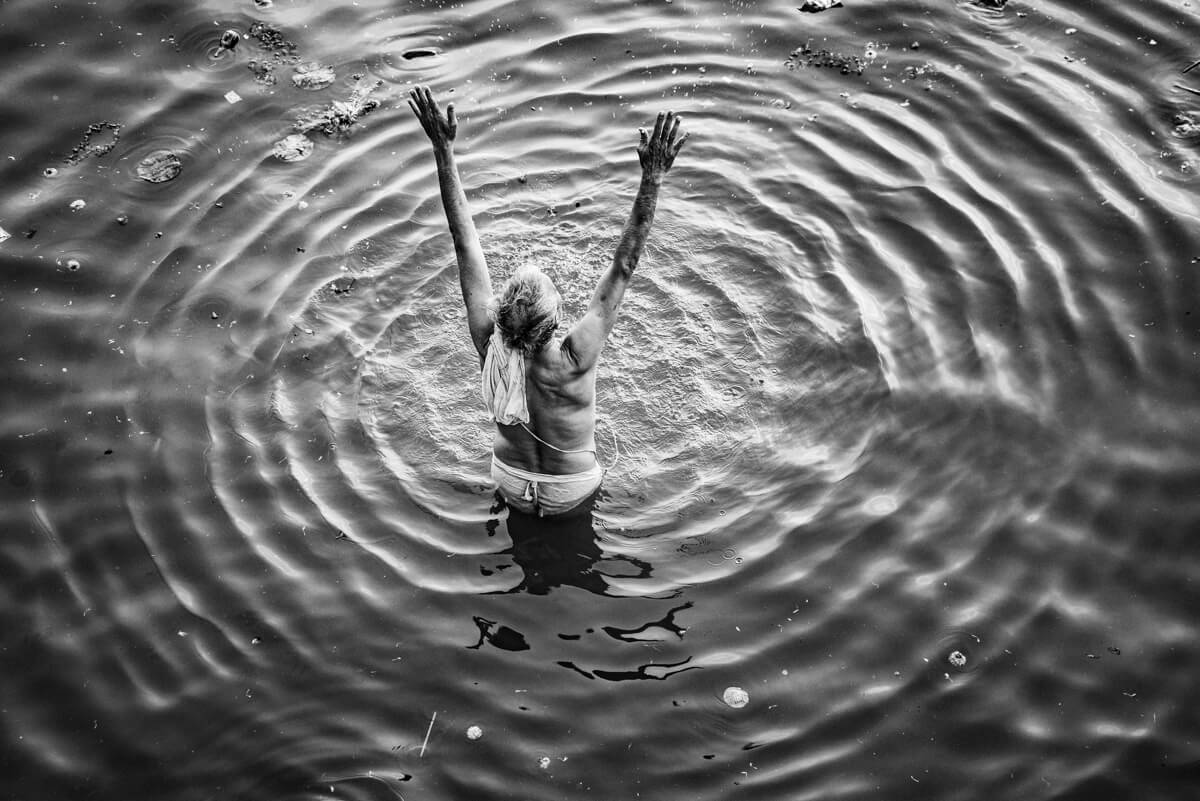
MYTH : Ganga the consort of the gods
Ganga is the only goddess consort of all three important male gods – depending on the mythology: Shiva, Vishnu, and Brahma
As Brahma’s wife she always travels with him in the form of water in his kamandalu, water-pot.
In Hindu iconography, Shiva, is depicted as Gangadhara, the “Bearer of the Ganges”, with Ganga, shown as spout of water, rising from his hair. Their relationship is both perpetual and intimate – Shiva is sometimes called Uma-Ganga-Patiswara (“Husband and Lord of Uma (Parvati) and Ganga”).
Shakti, as water, this moving energy can be felt, tasted, and absorbed. The war-god Skanda addresses the sage Agastya in the Kashi Khand of the Skanda Purana in these words:
One should not be amazed … that this Ganges is really Power, for is she not the Supreme Shakti of the Eternal Shiva, taken in the form of water?
This Ganges, filled with the sweet wine of compassion, was sent out for the salvation of the world by Shiva, the Lord of the Lords.
Good people should not think this Triple-Pathed River to be like the thousand other earthly rivers, filled with water.
She is also Vishnu’s consort. Not only does she emanate from his foot as Vishnupadi in the Avatarana story, but is also, with Sarasvati and Lakshmi, one of his co-wives.
According to the Bhagavad Gita 10.31, Lord Krishna declares when imparting the highest spiritual knowledge to Arjuna:

“Of purifiers I am the wind, of the wielders of weapons I am Rama,
of fishes I am the shark, and of flowing rivers I am the Ganga.”
It is said that Radha was so upset by Krishna’s fondness for Ganga, that Ganga hid herself under Krishna’s feet in her water form.
MYTH : Ganga mother of the gods
According to Mythology of the Ganges river or Mother Ganga, she is not only the mother of the Indian people, several Hindu scriptures describe Ganga Mata and her children:
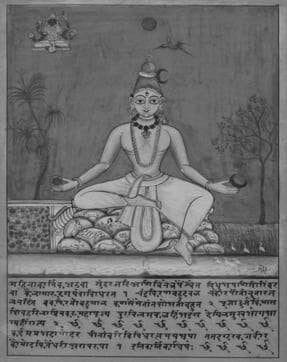
Kartikeya – foster-son ofGanga
According to the Skanda Purana, the goddess Ganga is foster-mother to Kartikeya or Kartika, Subrahmanya, Murugan, who was actually a son of Shiva and Parvati.
Kumara, son of Ganga and Shiva
The Shiva Purana mentions that the son of Lord Shiva was destined to salvage Earth by leading the Devatas – the divine forces – to drive out the Asuras – the evil forces – who had taken possession of earth. In order to hasten the birth of this divine son, the Gods decided to steal Lord Shiva’s Bija (seed) by interrupting his love play with Goddess Parvati, at the precise moment of emergence of the Bija from Lord Shiva. The interruption led to the seed to fall on the ground.
Agni – the Fire God, assumed the form of a white dove and picked it up and flew away. Having emerged from Lord Shiva himself, the seed had immense power and fire stored within it – so much that even Lord Agni found it difficult to keep holding it in his beak and he let go off it and dropped it in the Ganges.
Ganga then carried the seed with her and as instructed by Lord Brahma, deposited it in a sacred reed grove in the Saravana forest, situated on her shores, where the divine child was born after 10,000 years.
Lord Shiva then proclaimed that this celestial child be known by six different names, to be known as the son of six different creators. He was to be known as Kartikeya as the son of the Kritikas or the six sacred Pleiades, whose wives had nourished him. As the son of Agni he was to be known as Mahasena. As the forest Saravena’s son, he was to be known as Saravana. As Parvati’s son he would be known as Skanda and as his own son, as Guha. And finally, Lord Shiva proclaimed that the child would be known as Kumara, as the son of Ganga.
Ganesha – Gangeya (the son of Ganga)
Parvati is said to have created an image of Ganesha out of her sacred impurities which became endowed with life after immersion in the sacred waters of the Ganges. Therefore, Ganesha is said to have two mothers—Parvati and Ganga and hence is called Dvaimatura and also Gangeya, the son of Ganga.
In southern India also Vokkaliga Gowda and Kongu Vellalars are said to originate from mother Ganga.
Bhishma – son of Ganga

The Hindu epic, Mahabharata, tells that the Vasus, cursed by Vashishta, had requested Ganga to be their mother. Ganga incarnated and became the wife of King Shantanu on condition that at no stage shall he question her actions or she would leave him. As seven Vasus were born as their children, one after the other, Ganga drowned them in her own waters, freeing them from their punishment and the king made no opposition. Only when the eighth was born did the king finally oppose his wife, who therefore left him. So the eighth son, Dyaus incarnated, remained alive, imprisoned in mortal form and later became known in his mortal incarnation as Bhishma (Devavrata), who is one of the most respected characters of Mahabharata.
THE GANGES RIVER
The spiritual potency comes not from the Ganges’s 2,500 km or 1500 mile length, rather, its basin supports half of India’s population – plus nearly the entire population of Nepal and much of Bangladesh’s.
“If the Ganges thrives, India thrives & if the Ganges dies, India dies”
~ anonymous
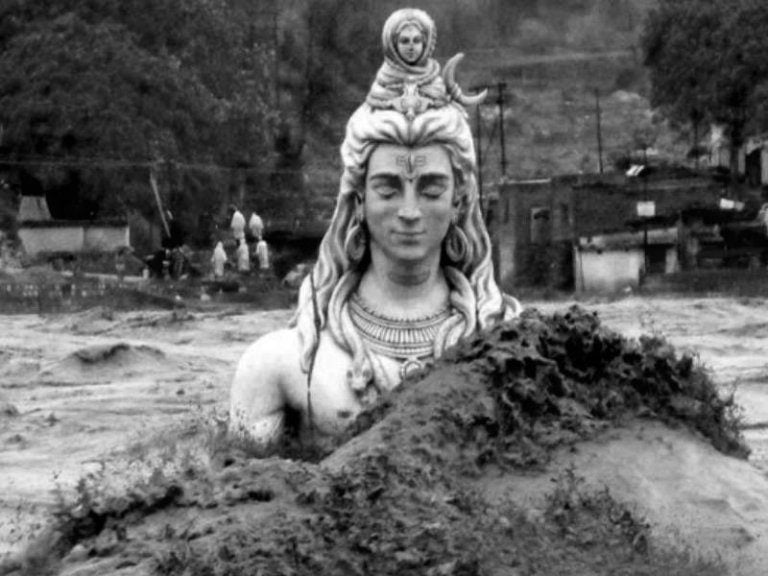
The Ganga is the distilled lifeblood of the Hindu tradition, of its divinities, holy scriptures, and enlightenment. As such, her worship does not require rites of invocation, her divinity is immediate and everlasting, but only for as long as the river survives.
In India the majority of rainfall, happens due to the seasonal Monsoon, heavy rains can result in catastrophic events like slides, floodings and avalanches along the Ganges.
The Gangotri glacier which is the source of Ganges River and one of the largest glaciers in the Himalayan Range is retreating, effecting the water level of the perennial river. 15 million inhabitants living on the low-lying flood plains of the Ganges delta are at risk from the rising sea level.
Pure and fertile
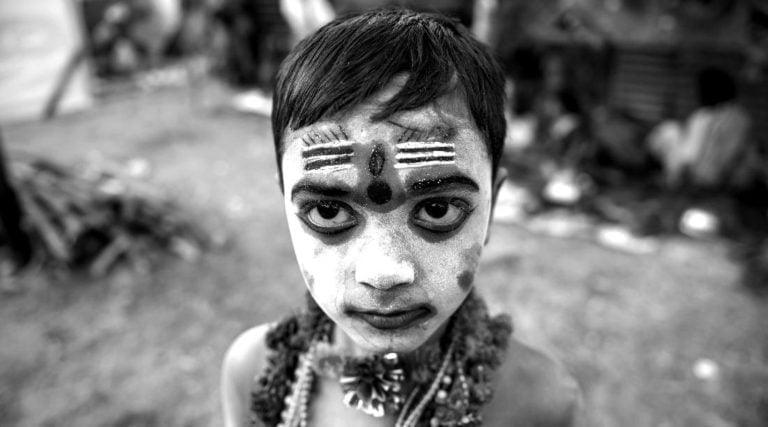
Majestic rivers imbibe eminent culture: the Nile does the Egyptian, the Huang He the Chinese, and the Ganges the Indian civilization. For its water and fertile sediment, the river is important to the people of the Ganges basin. They are dependent on irrigation, transportation, fishing, drinking and carrying out their livelihood.
Large dams have been constructed across the river to harness hydro energy and for regulation of the water flow , like Farakka, Tehri, and Bansagar dam. If there is insufficient water in the Ganges it could lead to crop failure and rise the price of agricultural commodities.
Pure and polluted
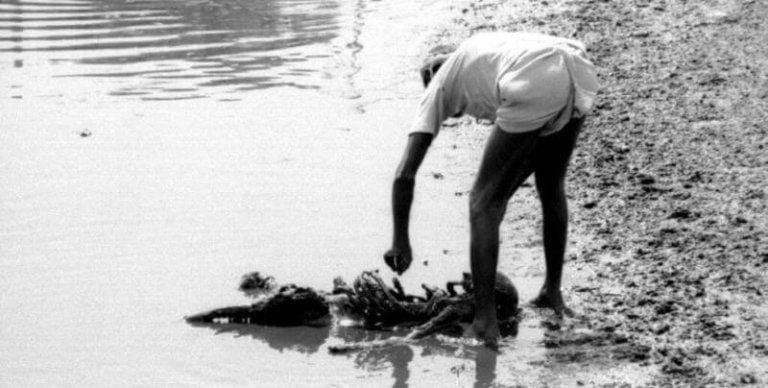
Though the sacred waters are linked to spiritual purity, the Ganges is one of the most polluted rivers in the world. Nearly 80 percent of the sewage dumped into the river is untreated, and the amount of human fecal matter is more than 300 times the limit set by India’s Central Pollution Control Board.
This is in addition to the toxic waste caused by dumping of pesticides, metals, and industrial pollutants. Raw sewage, plastic bags and bottles, industrial effluents, human waste, chemicals from tanneries, discarded idols, cow dung, partially cremated corpses, garlands of flowers, human remains, animal carcasses, butcher’s offal, chemical dyes from sari factories and construction waste ends up in the sacred Ganga.
These dangerous levels of pollution do little to deter religious practice from the sacred river. Hindus believe drinking water from the Ganges brings fortune, while immersing oneself or one’s belongings brings purity.
A dip in the Ganga may make worshipers spiritually pure,
but the pollution of the water afflicts thousand with
diarrhea, cholera, dysentery, hepatitis A and even typhoid each year.
Mata Js advice
Mata J, is a holy woman, wearing the orange. She is shiny and soft, in her late 50ies, her sister a little older, but also joyful and warm — both married to Krishna and untouched by man. We met the holy sisters, in a Himalayan ashram, they where escaping the heat of Mathura, of Vrindavan, Krishna’s birthplace, where they run a hospital and ashram together. Warmly and convivial we sat together, sipping milk tea and eating delightful sweets. Mata J told us, that after bathing and sipping from the holy Ganga, she got a nasty skin disease:
“No Ayurvedic medicine would help, I had to take antibiotics for several weeks, it took me over six months to fully recover.”
“If you go to visit Ma Ganga, keep your lips tight, a small drop of water can make you sick, and do not bath at a Kumbha mela, like I did. Bath in Gangotri, the source of the river and everywhere on the way to Haridwar, where she comes down from the Himalaya to the plains. In Hardwar you better not go into the Ganga, that is where I got sick. Try to avoid all other principle centers for the worship of the Ganga like Allahabad, where she joins the Yamuna – also sacred and polluted; – Varanasi, the holy city; and Sagar Island where she finally flows into the Bay of Bengal.”
As we asked if she would bath again in the Ganga, her face shines:
“Of course…”
Ganga bears no contradictions as breathing flesh of the living and blowing ashes of the dead intermingle with no nervousness. For devotees the waters of Ganga are always pure no matter how much filth is dropped into its arteries. For science the mighty river is suffocating and dying. No one knows how Ganga will breathe in the future.
Pure and worshiped

Pilgrims along the course of the River Ganges
The Ganges river has its source in the Gangotri glacier in the lofty Himalayas. Bindu -Sar – near Gangotri is referred to as the spot where the saint Bhagirata is believed to have carried out his penances. At its origin, the river is thus referred to as Bhagirati.
The rivers Jahnavi and Alakananda merge with the Ganga in the Himalayas. On the banks of the Alakananda is the ancient Himalayan pilgrimage town of Badrinath. Heading down through Rishikesh, associated with the descent of the river Ganga. The river descends down to the plains at Haridwar – also referred to as Gangadwara.
The Ganga then flows through the states of Uttar Pradesh and Bihar through the ancient pilgrimage towns of Varanasi or Benares and Allahabad or Prayag. Prayag (Triveni Sangamam) marks the confluence of the river Yamuna with the Ganga.
Before reaching the ocean, the river divides itself into several streams, and drains into the Bay of Bengal.Merging with the Ganga here is the river Bhramaputra. The Ganga also assumes other names such as the Padma and the Meghna. Finaly in the Bay of Bengal Ganga meets the ocean at Sagar Island or Gangasagar – said to be the location of the hermitage of Kapila Muni. He is associated with the legend of Bhagiratha and the descent of the river Ganga.
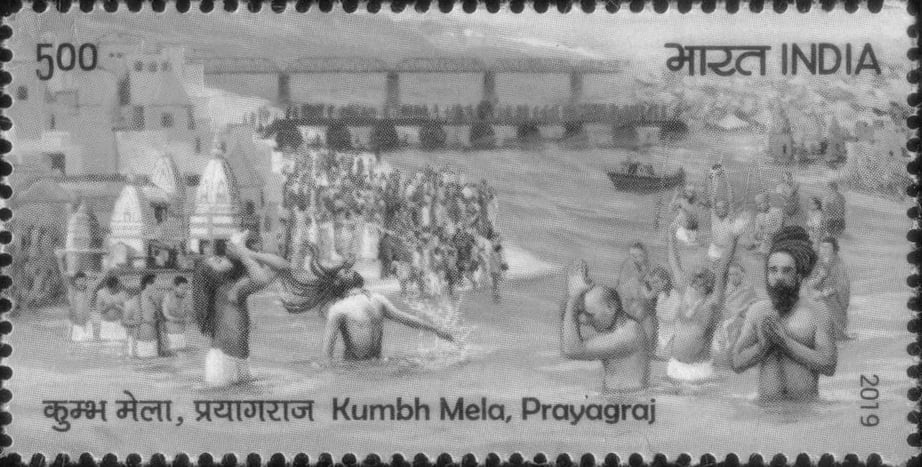
Sagar Island गंगा सागर

The Sagar Island is where the Ganges flows into the Bay of Bengal and a sacred place for pilgrims.
MYTH : How the Ganges Delta and therfore the Sagar Island came to be
Goddess Ganga, once lived on Mount Kailash and flowed demurely for the sole pleasure of the Gods.
Myth has that Sagar, King of Oudh, the 13th ancestor of Lord Rama and descendant of Sun God (Suryavanshi), had performed the Ashwamedha Yagna, or the horse-sacrifice, 99 times. This ceremony consisted in sending a horse round the Indian world, with defiance to all the earth to arrest its progress. If the horse returned unopposed, it was understood to be acquiescence in the supremacy of the king, and the horse was then solemnly sacrificed to the gods.
When King Sagar made preparations for the 100th sacrifice, Indra, King of Heaven, who had himself performed the ceremony a 100 times, jealous of being displaced by this new rival, stole the horse, and concealed it in a subterranean cell, where the sage Kapila, or Kapila Muni, was absorbed in meditation, dead to all occurrences of the external world.
The sixty thousand sons of Sagar traced the horse to its hiding place, and believing the sage to be the author of the theft assaulted him. The holy man being thus roused opened his eyes and cursed the assailants, who were immediately burnt to ashes and sentenced to the underworld. Sagar heard of this fate through Narada (devotee of Lord Narayana- Vishnu), the heavenly wanderer, and sent the grandson Ansuman to undo the harm. Ansuman descended to the underworld and met Kapila, who was much pleased with the youth’s bearing and conversation. He granted that the souls of the sons of Sagar may be released by the waters of Ganga, then resident in heaven. Despite much austerity and prayer, neither Sagar nor Ansuman after him, nor his son Dilip could get Ganga to appear on earth.
Finally it was Dilip’s son Bhagiratha, who after severe austerities, propitiated the Goddess, and she agreed to come down to earth and then to the underworld to rescue the tormented souls of the sons of Sagar. However, the impact of her fall would be so severe, that it could be borne by none less than Lord Shiva himself. Therefore Bhagiratha went into meditation again and obtained Shiva’s consent after many more austerities.

The river came down and fell into Lord Shiva’s matted hair, (this manifestation of Lord Shiva is known as Gangadhara), from where she separated into seven streams, of which three flowed to the east and three to the west. The seventh stream followed Bhagiratha to earth and then to the underworlds.
Bhagiratha patiently led the river down to the sea from the Himalayas and for this reason the Ganges is also known as the Bhagirathi. However, being unable to locate the exact spot where the ashes lay, he requested Ganga to follow her own course.
Ganga, therefore in the region of Bengal, divided herself into a hundred mouths and formed the Ganges delta. One of these streams washed the ashes, and offered salvation to the souls of the departed.
In this way the children of Sagar were saved and an ocean formed from the waters there.
Also the Ganges is believed to flow in the three worlds – heaven, earth and the nether world (patala- where the ashes of the sixty thousand sons of King Sagar lay): Thus the Ganga is known as “Three Path River”.
The Gangasagar fair and pilgrimage is held annually on Sagar Island’s southern tip, where the Ganges enters the Bay of Bengal. The pilgrimage and fair held on the Sagar Island is the second largest congregation of mankind after the triennial ritual bathing of Kumbha Mela.
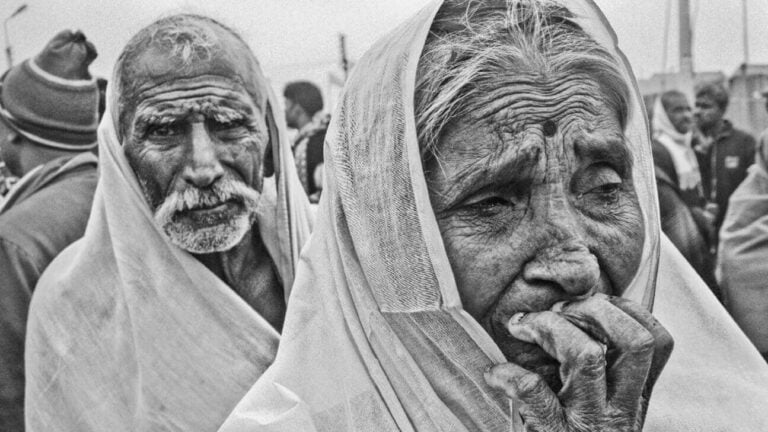
In January every year, many pilgrims at the Gangasagar fair in West Bengal get separated from their families – or abandoned by them. They end up at a shelter, where they wait to be reunited with their loved ones. An elderly woman from Rajasthan waits in line to give information about herself and her family – hoping that they will eventually find her.
Prayag or Allahabad इलाहाबाद
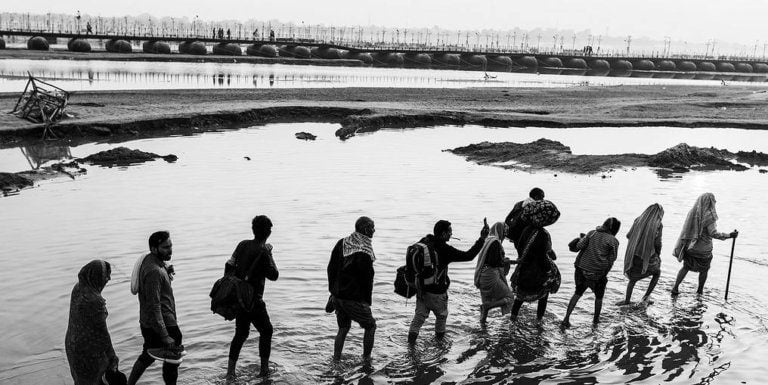
At Allahabad, the “three” rivers meet and flow into each other. The mystery of the rivers intensifies because the two rivers, Ganga and Yamuna, are real whereas the third river, Saraswati, though mentioned in the sacred scriptures, no longer exists anywhere in the subcontinent, as it dried out.This confluence summons the songs and sentiments of profound religiosity and romance.
And yet for the devotees and lovers, Saraswati flows and dissolves into Ganga, the mother-river that welcomes the visible and the invisible offspring.
MYTH: The origin of the Kumbh Mela
Prayag is associated with the legend of the celestial nectar of immortality – Amrita.
The myth tells of a battle between the Devas and Asuras for amrita, the nectar of immortality. During samudra manthan, or churning of the ocean, amrita was produced and placed in a kumbha (pot). To prevent the asuras (malevolent beings) from seizing the amrita, a divine carrier flew away with the pot. In one version of the legend, the carrier of the kumbha is the divine physician Dhanavantari, who drops it in four places where the Kumbh Mela is celebrated. In other re-tellings, the carrier is Garuda, Indra or Mohini, who spills the amrita at four places.
The festival is celebrated four times over the course of 12 years, as it takes almost 12 years for Jupiter to transverse to complete zodiac. The site of the observance rotating between four pilgrimage places on four sacred rivers— at
- Haridwar on the Ganges River,
- Ujjain on the Shipra,
- Nashik on the Godavari, and
- Prayag orAllahabad at the confluence of the Ganges, the Yamuna, and the mythical Sarasvati.
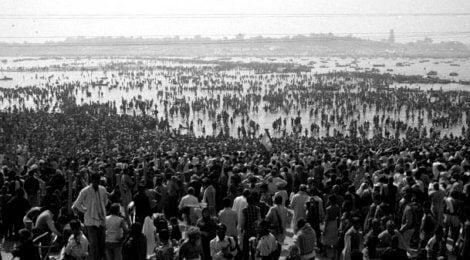
The normal Kumbh Mela is held every 3 years, the Ardh (half) Kumbh Mela is held every six years at Haridwar and Allahabad (Prayag) while the Purna (complete) Kumbh mela takes place every twelve years, at four places Prayag (Allahabad), Haridwar, Ujjain, and Nashik, based on planetary movements. The Maha Kumbh Mela is celebrated at Prayag after 144 years (after 12 ‘Purna Kumbh Melas’).
At Prayag; the 2001 festival attracted some 60 million people.
Depending on what position the Sun, Moon, and Jupiter hold in that period in different zodiac signs, the venue for Kumbh Mela is decided.
The Kumbha mela, is inscribed on the UNESCO’s Representative List of Intangible Cultural Heritage of Humanity.
Pilgrims, gathered together to be freed from the vicious earthly cycle of life and death and move towards a heavenly realm, which knows no suffering or pain.
Benares or Varanasi वाराणसी
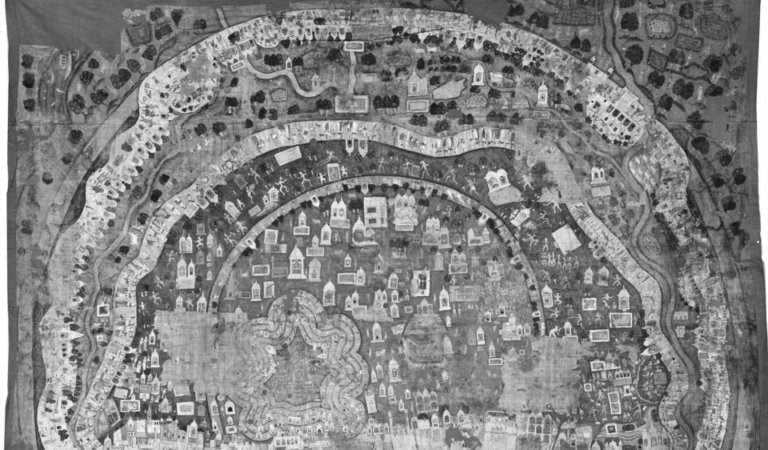
Nearly 4000 dead bodies are cremated daily on the riverside ghats in the city of Varanasi alone. Scattering ashes of loved ones into Ganga is a custom to be followed by devote Hindus, as it is believed, this will help the dead attain Moksha – salvation.
And so for centuries Ganga jal has marked births, weddings and deaths.
For many Hindus the world over, nothing is more holy or pure than Ganga jal, or water from the Ganges. Many families keep a vial of Ganges water in the house as auspicious and also necessary to give to a dying person to drink.
Mark Twain famously said:
“Benares is older than history, older than tradition, older even than legend, and looks twice as old as all of them put together.”
Once, Benares or Varanasi, one of the oldest continuously inhabited cities in the world, boasted a glorious civilization. Music, dance, poetry and religious thought flourished here. A few kilometers away is Sarnath where the Buddha gave his first sermon.

Today it is a slum. The city is pot-holed, full of rubbish where chicken, goats, dogs and cows rummage, roadside eateries serve food right next to open sewers swarming with flies, people eat snacks and throw the plastic wrappers on to the street, men spit, urinate and defecate in pubblic, and the roads are engorged with noisy, chaotic traffic.
The water quality at Allahabad and Varanasi is not suitable for bathing.
Haridwar हरिद्वार
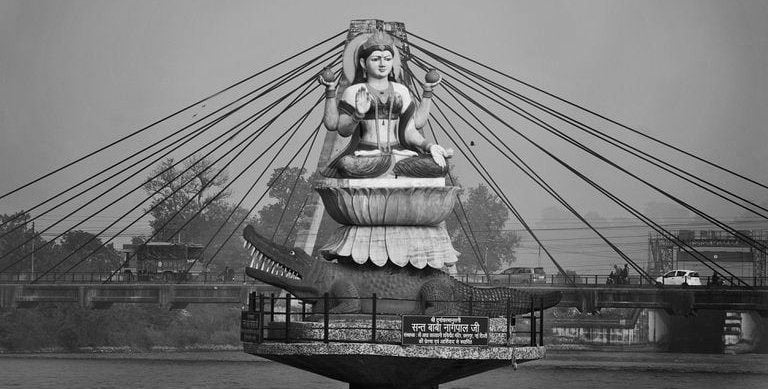
Shaivaites (follower of Lord Shiva) and Vaishnavites (devotees of Lord Vishnu) call this place Hardwar and Haridwar individually, relating to Har being Shiva and Hari being Vishnu.
It is believed that several yogis and sages lived and practiced penance here, Haridwar or Hardwar is steeped in myth and lore.
A short drive from Hardwar, near Rishikesh there is the Neelkanth Mahadev Temple. According to mythology and Hindu history, it was here that Lord Shiva consumed the venom [kaalkut] churned out of the milk ocean – the ‘ Samudra Manthan’ -, saving the world from evil, death and destruction. The poison turned his throat blue, so Shiva got his name Neelkanth, literally translating to ‘The Blue Throated One’. In Haridwar, Goddess Ganga descended when Lord Shiva released the mighty river from his hair.
MYTH: Samudra manthan or Churning of the Ocean of Milk
Devtas (Gods) and Asuras (Demons) churned the sea using Shivas snake in order to obtain Amrita, the nectar of immortality.
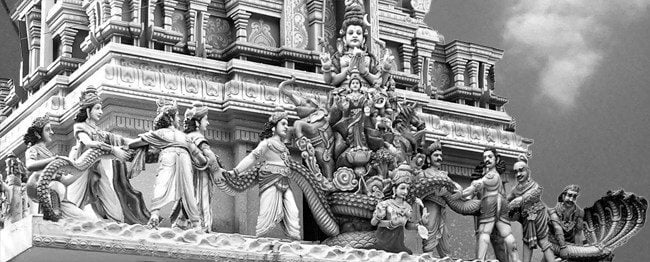
According to Puranas the Samundra manthan took place in the month of Shravan or Saawan. Wonderful treasures were brought up from the depths:
- Chandra, the moon,
- Parijata, a beautiful and fragrant tree now planted in Indra’s heaven,
- the four-tusked elephant Airavata, Indra’s mount,
- Kamadhenu, the cow of plenty,
- Madira, the goddess of wine, who became Varuni, the wife of Varuna,
- Kalpavriksha, the wish-fulfilling tree,
- the Apsaras (celestial dancers),
- the celestial horse Uccaihshravas,
- the goddess Lakshmi, who became Vishnu’s wife,
- Panchajanya, Vishnu’s conch,
- Vishnu’s mace and magic bow,
- various gems, and
- & 14. Dhanvantari, the physician of the gods, who rose up out of the waters carrying in his hands the supreme treasure, the amrita.

along with the poison – halahal or kalkut. But the demons and the Gods were unsure of what to do with the poison, as it had the ability to destroy everything.
Lord Shiva then stored this poison in his throat, which became blue. Due to the venom, Lord Shiva’s body started to burn and thus in order to provide him relief from the burning, all the Gods and Demons started offering water from the holy Ganga to him.
This is how the practice of offering water to Shiva began. Carrying Ganga jal [Ganga water] and pouring it on a Shiva- linga is an important form of worship for Shivaites.

The origin of the Kanwar Yatra
The tradition of offering gangajal to Lord Shiva has been going on ever since. Devotees of Lord Shiva, Kanvarias throng the Neelkannt temple in huge numbers, every year during the holy month of Shravan. As Lord Shiva saved the universe in this place, by drinking the destructive poison, this is why this entire month is dedicated to him and is considered very auspicious. Kanwar Yatra is an auspicious pilgrimage observed by the devotees of Lord Shiva annually. In this practice, the bearer is known as ‘Kanvarias’, they pilgrimage the Sultanganj in Bihar, Gangotri and Gaumukh in Uttarakhand and Haridwar to fetch water from the Holy Ganges and then offer the ‘Gang Jal’ in the local Lord Shiva temples.
Kumbha Mela
Also, according to the Samudra manthan, Haridwar is one of four sites where drops of Amrit, the elixir of immortality, accidentally spilled over from the pitcher while being carried away from the demons.
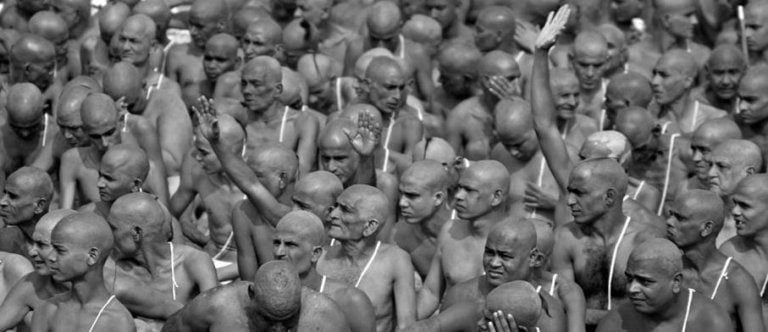
This is manifested in the Kumbha Mela, which is celebrated every 12 years in Haridwar. During this Kumbh Mela, millions of pilgrims, devotees, and tourists congregate in Haridwar to perform ritualistic bathing on the banks of the river Ganges to wash away their sins to attain Moksha. Which means to free, let go, release, liberate [Sanskrit: मुच्, muc] it refers also to freedom from saṃsāra, the cycle of death and rebirth.
THE ORIGIN OF GODDESS GANGA
Mythology of the Ganges river or Mother Ganga
“India is great, the Himalaya are great, but the region in the Himalayas where Ganga is born is especially great because that is the place where She [Ganga] exists in confluence with Narayana [or Vishnu].”
~ Skanda Purana
Gangotri गंगोत्री
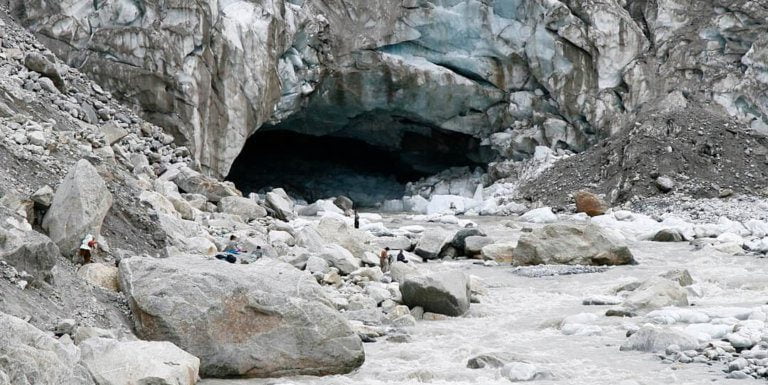
The origin of the holy river is at Gaumukh गौमुख, set in the Gangotri Glacier a 19 km trek from Gangotri, here Ganga is called Bhagirathi. Gangotri lies at a height of 3,100 metres or 10,200 ft.
The Ganges River is formed by the confluence of River Bhagirathi and River Alaknanda at Devprayag in Uttrakhand. Before Devprayag the two rivers originate from different glaciers and travel southwards to meet at Devprayag. From Devprayag onwards Ganga meets the Alaknanda.
Gomukh is mentioned in the Puranas. It is said there that searching a lost sheep a shepherd boy reached near a glacier in Gangotri, the snout of which exactly looked like the mouth of a cow, and thus it got its name ‘Gomukh’. From then many saints, holy travelers, as well as religious people went there to worship the place.
It was in Gangotri, that Goddess Ganga descended when Lord Shiva released the mighty river from his hair.
There are numerous versions of myths regarding the origin of goddess Ganga. Told and retold in the Ramayana, the Mahabharata and several Puranas.
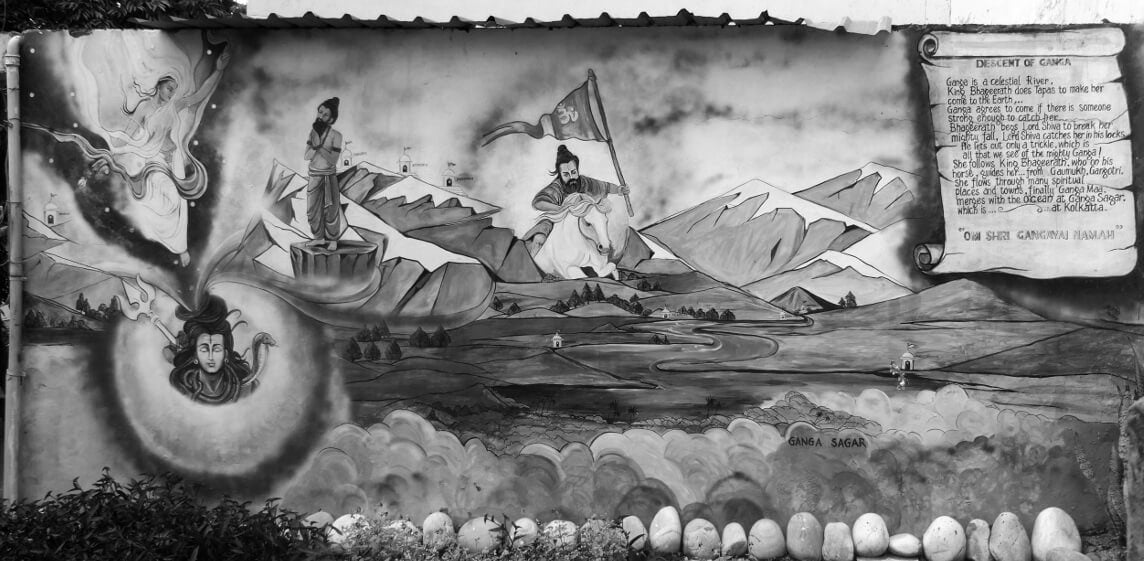
MYTH : How Goddess Ganga came to earth
How the Ganges Delta and therefore the Sagar Island came to be
The most popular myth revolves around a king: Sagara, his sons, grandson (Ansuman) and the great grandson, Bhagirath.
Raja Sagar had sent out the horse as part of Ashwamedha yajna which was supposed to run uninterrupted and come back. This would have established the unchallenged supremacy of the king.
Lord Indra captured the horse and tied it near to where sage Kapil was sitting in meditation. The 60000 sons of the king rushed to rescue the horse and turned to ashes when sage Kapil opened his eyes in anger.
Raja Bhagirath, grandson of the king was determined to liberate the souls of his ancestors and did severe penance. He was advised by wise men that the only way for his ancestors to attain moksha (liberation from the cycle of life and death) was to bring the goddess Ganga to earth.
After years and years of penance, Ganga was pleased and agreed to come to earth. But she knew earth would not be able to hold her might. Bhagirath persevered and she only provided him with the solution to this problem.
If Lord Shiva agrees to hold her as she comes down from heaven, she may be released slowly to the earth.
Bhagirath continued his penance and pleased Lord Shiva who held Ganga in his jatas (dreadlocks).
He opened one strand of the jata and Ganga descended on to earth.
The place where she touched earth is known as Gangotri. As Ganga flowed past sage Kapil’s ashram, Bhagirath’s ancestors were liberated.
Ganga Dussehra
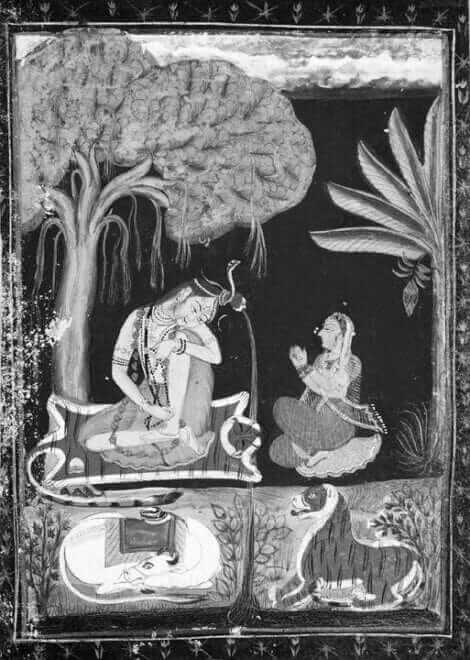
Ganga Dussehra, also known as Gangavataran, is the Hindu festival celebrating the avatarana (descent) of the Ganges.
On the tenth day of the bright half of Jyeshthah (last week of May),
Goddess Ganga began to flow from heaven to the matted hair of Lord Shiva,
and from the hair of Lord Shiva she began to flow on earth.
This first ten days, known as Dashahara, are dedicated to honor of Mother Ganga.
Bhagavat- Padi or Vishnupadi
Bhagavata Purana depicts the birth of the Ganga. According to the myth, Vishnu in one of his incarnations appeared as Vaman in the sacrificial arena of Asur King Mahabali. Then in order to measure the universe, he extended his left foot to the end of the universe and pierced a hole in its covering with the nail of his big toe. Through the hole, the pure water of the Causal Ocean (Divine Brahm-Water) entered this universe as the Ganges River. Having washed the lotus feet of the Lord, which are covered with reddish saffron, the water of the Ganges acquired a very beautiful pink color.
Because the Ganges directly touches the lotus feet of Lord Vishnu (Narayana) before descending within this universe, it is known as Bhagavat- Padi or Vishnupadi which means Emanating from the lotus feet of Bhagavan (God).
It finally settles in Brahmaloka or Brahmapura, abode of Lord Brahma before descending to planet Earth at the request of Bhagiratha and held safely by Lord Shiva on his head to prevent destruction of Bhumi Devi (Mother Earth).
Vishnu Purana
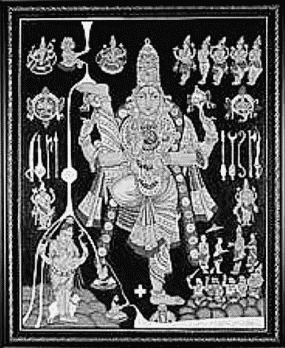
The Vishnu Purana describes the birth of Ganga in the following manner:
She is said to have originated from the big toe of Lord Vishnu’s left foot. Dhruvah, the pole star, received her in her descent and sustained her day and night on his head, while the seven Rishis (the Pleiades) performed their ablutions in her waters (because the Pleiades revolve around the Pole Star).
Ganga then encompassed the orb of the Moon by her currents, which added to the luminary’s brilliance.
Thereafter, having issued from the Moon, she alit upon Mount Meru, and then flowed in four branches to the four corners of the Earth for the sake of its purification. The name of these branches are Sita, Alakananda, Chaksu and Bhadra.
The southern branch, Alakananda, was held affectionately by Lord Shiva on His head for one hundred divine years and then was released from His matted locks.
Hence Lord Shiva is depicted in Indian iconography with a crescent Moon on his head, from where a shoot of water springs forth.
Thereafter, the southern branch of Ganga journeyed through India and divided itself into seven rivers which flow into the southern ocean. Hence Alakananda is known as the most sacred river of the four branches.
Valmiki Ramayana
According to Valmiki Ramayana, Ganges was the daughter of Himalaya and Menaka. The deities abducted her and took her to heaven. From that time onward Ganga started living inside the Karmandala (a spout shaped vessel).
Krittivas’ Ramayana
According to Krittivas’ Ramayana the deities had taken Ganga to Lord Shiva to get married with him. When Menaka did not find her in the house, she cursed Ganga to attain the form of water.
On Gangas name “Jahnvi” or “Jahnusta”
Another myth regarding Ganga has it that Ganga followed Bhagiratha and because of his tremendous speed, all the villages, forests etc. in the way were either getting submerged or drowned. Sage Jahnuh who was doing a yagna (pilgrimage) in his hermitage got angry when his home was submerged in the Ganga. He drank whole of the Ganga by his yogic power. At this the deities, and the men became restless and they requested Jahnuh to release Ganga. Jahnuh released Ganga from his thigh by cutting it and for this reason Ganga is also called “Jahnvi” or “Jahnusta”.
Rigveda 3.58.6 says
“your ancient home, your auspicious friendship,
O Heroes, your wealth is on the banks of the Jahnavi (JahnAvyAm)”.
Many creeds interact with Ganga
The Mythology of the Ganges river or Mother Ganga is not only important for Hindus, even though its mystification in Hindu scriptures and rituals is most extensive and unique.
The Ganga tales portray miracles of the Buddha crossing a ferocious river both with and without boats. The sacred city-state of Vaishali founded on the banks of Ganga in 600 BC, hosted the Buddha’s last sermon.
Vaishali claims to be the birthplace of Lord Mahavir, the originator of Jainism.
Guru Nanak, the founder of Sikhism, bathed in Ganga to expand its blessings for the people of Punjab.
Islam’s relationship with Ganga is complicated. Unlike Hinduism, Buddhism, Jainism, and other native creeds, the iconoclastic Islam had little use for idols, myths, and superstitions. Early Muslim invaders and their progeny, recounts Professor Sen, in his book Ganges: The Many Pasts of an Indian River, razed to the ground “nearly a thousand temples” in sacred cities on the banks of Ganga.
The complicated relationship lingered in the Mughal empire. Akbar, the most tolerant Muslim emperor, capped an ancient well in Prayag or Allahabad where Hindus had been for centuries committing suicide in the hope of escaping “the endless karmic cycle of life and death,” but the emperor saved the nearby sacred banyan tree in a newly built chamber for Hindu pilgrims. The Mughals also built the Taj Mahal, a lasting architectural monument celebrating the quintessential Indian romance.
“Water is the source of all life.”
~ The Qur’an
Jawaharlal Nehru, a religious iconoclast himself, asked for a handful of his ashes to be thrown into the Ganges. He wrote in his will:
“The Ganga, is the river of India, beloved of her people, round which are intertwined her racial memories, her hopes and fears, her songs of triumph, her victories and her defeats.
She has been a symbol of India’s age-long culture and civilization, ever-changing, ever-flowing, and yet ever the same Ganga.”

~ ○ ~
Keep exploring:
Works Cited & Multimedia Sources
Discover INDIA on earthstoriez
- Eck, D. L. Ganga: The Goddess Ganges in Hindu Sacred Geography. In J. S. Wulff, Devi: Goddess of India. 1996.
- Ganga action. https://web.archive.org/web/20230622114129/https://gangaaction.org/about-ganga/people/spirituality-culture/
- Ganga in Hinduism. https://en.wikipedia.org/wiki/Ganga_in_Hinduism
- Ganga Stotram – In sanskrit with meaning composed by Sri Adi Shankaracharya. https://www.greenmesg.org/stotras/ganga/ganga_stotram.php
- Ganga, the holy river of the Hindus. https://www.templepurohit.com/ganga-the-holy-river-of-hindus/
- Ganges river. https://sacredland.org/ganges-river-india/
- Ganges river. https://www.newworldencyclopedia.org/entry/Ganges_River
- Ganges. https://www.ancient.eu/Ganges/
- Glittering Currents of the Ganges River. The Christian Science Monitor.
- Holyganga. https://web.archive.org/web/20170130084025/http://www.uttaranchal.org.uk:80/holyganga.php
- Human and Environmental Stories Interweave in a Meandering Meditation on the Ganges River. Science.
- Kumbh Mela. Significance, Festival, & History. Britannica.com
- Mother Ganga. Indias holy river succumbs to pollution. https://in.reuters.com/article/us-india-ganges/dying-mother-ganga-indias-holy-river-succumbs-to-pollution-idINKBN19V0OG
- Pandey Sushant. Causes of Ganges River Pollution: A Case Study. https://knowledgeofindia.com/causes-ganges-river-pollution-case-study/
- Photography- http://www.abhishekhajela.com/-/galleries [thank you]
- Review: Ganges Explores Why the River Draws Pilgrims and Emperors Alike to Dip in Its Sacred Waters. Los Angeles Times.
- Spiritual & Cultural Heritage – Ganga. https://web.archive.org/web/20230622114129/https://gangaaction.org/about-ganga/people/spirituality-culture/
- Sudipta Sen. Ganges: The Many Pasts of an Indian River. 2019.
- The Ganges and its place in the firmament of the Hindu gods and religious belief. https://elaw.org/sacred-ganges-carries-toxic-pollution
- The Ganges: Hinduism’s Holy River. Why the Ganges Is Considered Sacred. Lean religions.
- The Ganges: holy, deadly river Pollution has turned the sacred waters into a lethal cocktail of industrial and human waste. Can the river be saved? https://www.ft.com/content/dadfae24-b23e-11e4-b380-00144feab7de
- The River Ganges http://www.templenet.com/Ganga/ganga.html
- The River Ganges. TempleNet.
- Unruly Waters and Ganges Review: In India, Water Is Politics. The Wall Street Journal.
- What the Ganges Means to India. Think.
